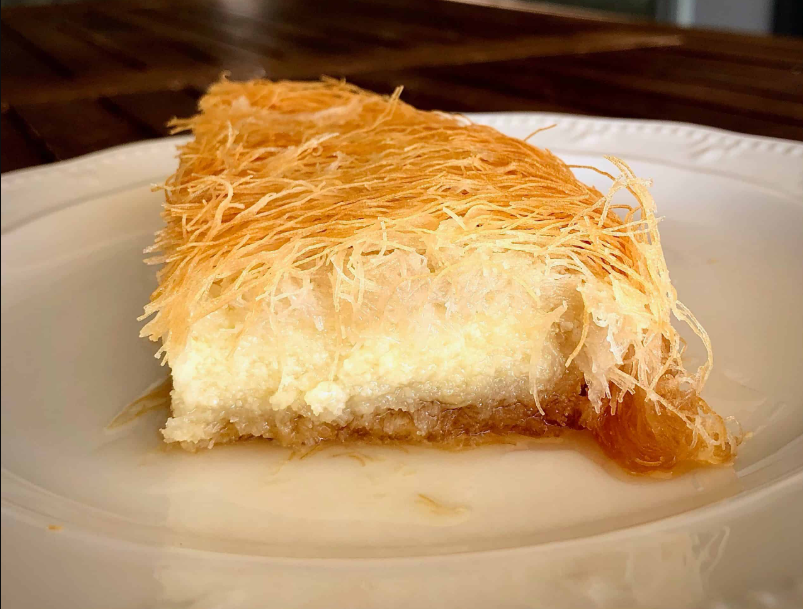kataifi A Delicate Web of History
The moment you bite into kataifi—the crisp, hair-fine pastry wrapped around a molten core of nuts, honey, or cheese—you taste more than sugar and butter. You taste centuries of trade routes, conquests, and domestic rituals. Unlike its famous sibling, baklava, kataifi rarely takes center stage in culinary folklore, yet its gossamer strands crisscross the entire Eastern Mediterranean, North Africa, and the Levant. Food historians trace its earliest written reference to the late Byzantine era, where cooks recorded a “kandakari”—a shredded dough used for ceremonial desserts in Constantinople’s palaces. Over time, Ottoman expansion ferried the technique east to Aleppo and west to Sarajevo, while Greek monasteries preserved it as part of Easter and Christmas fasting tables. That layered lineage explains why today you can find kataifi laced with orange-blossom syrup in Beirut, stuffed with pistachios in Gaziantep, or cradling creamy mizithra cheese on the islands of the Aegean. Each regional riff threads a new story into the pastry’s ever-evolving tapestry.
Table of Contents
The Alchemy of Spun Dough
At first glance kataifi dough looks like angel-hair pasta, yet the resemblance is superficial. Traditional dough begins with just three ingredients—soft wheat flour, water, and a whisper of salt. The magic lies in how it is cooked. Instead of rolling and cutting sheets, artisans whisk the batter to a pourable consistency, then drizzle it in skeins onto a rotating copper griddle set over a gentle fire. As the ribbons hit the hot surface, steam puffs through microscopic bubbles, setting the starches in seconds. The cook sweeps the strands off in a continuous veil, piling them into airy skeins that cool into feather-light bundles. When industrial production took off in the 1960s, rotating drums and precision nozzles replicated this motion, making kataifi frozen dough a supermarket staple from Melbourne to Montreal. Yet hand-pulled kataifi remains an endangered craft; in Istanbul’s backstreets, you can still glimpse masters aiming their pitchers with the steady wrist of a calligrapher, each swirling a living connection to medieval kitchens.
Sweet Traditions: From Honeyed Scrolls to Syrup-Soaked Nests
Classic sweet kataifi follows a template: wrap roasted nuts—most often walnuts or pistachios—in a snug cocoon of shredded dough, bake until amber, then drenched in a syrup perfumed with lemon or rose. The syrup’s role is twofold: it balances the pastry’s austerity and binds stray strands into a unified crunch. In Greece, melomakarona-style syrup bursting with cinnamon and clove is favored around Christmas, whereas in Egypt, shaadi stalls splash on date molasses for extra caramel depth. In Damascus, cooks fashion kataifi into bird-nest cups, fill them with clotted cream known as qishta, then shower them with powdered sugar—a scene-stealing finale at Ramadan iftar tables. Meanwhile, Cypriot confectioners sandwich quenelles of ice-cold vanilla gelato between warm katafi discs, achieving a play of temperatures that turns regulars into evangelists. Each variation showcases kataifi dough’s forgiving structure: its tiny filaments trap heat, allowing fillings to steam gently without turning soggy.
Savory Evolutions in Modern Kitchens
While travelers often meet kataifi through syrup and nuts, professional chefs have pushed it well beyond dessert. The strands’ high surface-area-to-volume ratio produces unmatched crispness, making kataifi a couture alternative to bread crumbs. In trendy bistros, you’ll find prawn tails swaddled in kataifi and flash-fried, so the pastry frills fan out like gilded coral. A sprinkling of Aleppo pepper and lime transforms them into the Mediterranean cousin of tempura. Greek tavernas fold sheep’s-milk feta and spinach into cigar-shaped rolls, selling them by the dozen to late-night revelers. In Dubai, molecular gastronomy labs encase slow-cooked lamb shank in kataifi, then bake it until the crust shatters under the diner’s fork, revealing meat that collapses into wisps. Even plant-based innovators have joined in, binding jackfruit “crab” cakes in kataifi to secure an oceanic crunch without seafood. The pastry’s neutral flavor acts as a blank canvas, happy to moonlight as either comfort food or avant-garde garnish.

Nutritional Lens: Indulgence with a Conscious Crunch
No honest writer would brand kataifi a healthy food; butter or clarified ghee is integral to its signature flakiness. A typical walnut-filled roll clocks in at roughly 250–300 calories, with saturated fat and sugar surging during syrup. Yet, there are ways to moderate indulgence. Swapping half the butter for extra-virgin olive oil drops saturated fat while adding fruity undertones that pair beautifully with citrus syrup. Nuts contribute protein and minerals like magnesium, and if you toast them lightly instead of deep-roasting, you preserve delicate antioxidants. Savory versions offer more room for nutrient-dense fillings—think spinach, pumpkin puree, or minced mushrooms bound with béchamel made from oat milk. Air-fryer devotees have also reported solid results, brushing strands with oil rather than drenching them and then cooking at high fan speed to coax out crispiness. Moderation remains key, but thoughtful tweaks let kataifi fit into a balanced diet without losing its soul.
Crafting Kataifi at Home: Tips from Artisans
Home cooks often shy away from kataifi dough, picturing a Medusa’s head of tangled threads. The truth: with a few tricks, it can be easier than phyllo. First, thaw frozen kataifi overnight in the refrigerator, never on the countertop, or condensation will gum strands together. Keep the dough under a barely damp towel to prevent drying; once brittle, the filaments snap instead of wrapping. When buttering, use a soft pastry brush in gentle downward strokes; rough dabbing compresses the network and sabotages flakiness. For neat cylinders, lay a strip of kataifi about 8 cm wide, sprinkle your filling at one end, and roll tightly like a sushi mat. Bake on a perforated tray to let hot air reach every side. Finally, always pour cooled syrup onto hot pastry—or hot syrup onto cooled pastry—never both hot or both cold; this ensures the strands drink in sweetness without becoming mush. With practice, you’ll discover kataifi is forgiving: any torn strands can be spritzed with butter and baked into crunchy topping for ice cream or savory casseroles.
Storing, Reviving, and Serving
Fresh kataifi pastries shine brightest within 24 hours when the contrast between the outer shell and moist core peaks. If you must store them, choose an airtight tin at room temperature; refrigeration turns syrupy desserts grainy. Before serving leftover rolls, reheat for five minutes at 160 °C (325 °F) to awaken aromas and restore crunch. Unsyruped, baked kataifi freezes well—wrap pieces individually, then revive them straight from the freezer in a moderate oven, applying syrup afterward. For an elegant presentation, scatter finely chopped pistachios over the rolls, add a tuft of candied orange peel, and drizzle a final thread of warm honey at the table. Pair sweet kataifi with thick Greek coffee that can stand up to its sweetness, or contrast savory versions with a crisp Assyrtiko white wine whose acidity slices through butter. However you serve it, slicing through those hair-thin layers will elicit the unmistakable shatter that marks kataifi done right.
Frequently Asked Questions
1. Is kataifi dough the same as shredded phyllo?
Essentially yes. Kataifi is often marketed as “shredded phyllo” because both start from the same basic batter of flour and water; the difference lies in how it’s dispensed and cooked. While phyllo forms broad, paper-thin sheets, kataifi is extruded into threads that set instantly on a hot plate, creating a radically different texture.
2. Can I make kataifi dough at home without special equipment?
It’s possible but tricky. Skilled cooks have improvised using a squeeze bottle pierced with several tiny holes and a flat nonstick pan kept at low heat. Maintaining a steady wrist and uniform flow is challenging, so most home bakers prefer buying ready-made frozen kataifi and focusing creative energy on fillings and syrups.
3. Why does my kataifi turn soggy after baking?
The chief culprits are either oversaturation with syrup or insufficient baking time. Ensure you bake until the strands are deep golden brown—pale yellow indicates trapped moisture. When adding syrup, use a ladle to control flow and stop once you see the pastry no longer absorbs quickly.
4. What savory fillings pair best with kataifi?
Seafood—especially shrimp, scallops, and crab—benefits immensely from kataifi’s delicate crunch. On the vegetarian side, herbed goat cheese, sautéed spinach-feta mixtures, or spiced pumpkin puree work well. Ground meats like lamb or chicken kofta are traditional in parts of Anatolia, often served with a yogurt-tahini drizzle.
5. How long can baked kataifi be stored?
Sweet, syrupy kataifi is kept for three to four days in an airtight container at room temperature. Beyond that, the strands lose crispness, and the syrup can ferment subtly. Unsyruped pastry can be frozen for up to two months; reheat in a 180 °C (350 °F) oven until hot before soaking in fresh syrup.
From medieval palace feasts to contemporary tapas bars, kataifi remains a testament to culinary ingenuity—proof that a handful of humble ingredients, spun with patience and skill, can weave a delight that transcends borders and centuries. Whether you savor it drenched in orange-blossom honey or wrapped around a sizzling prawn, every crunchy strand invites you to trace the ancient threads of this shredded-dough marvel.

